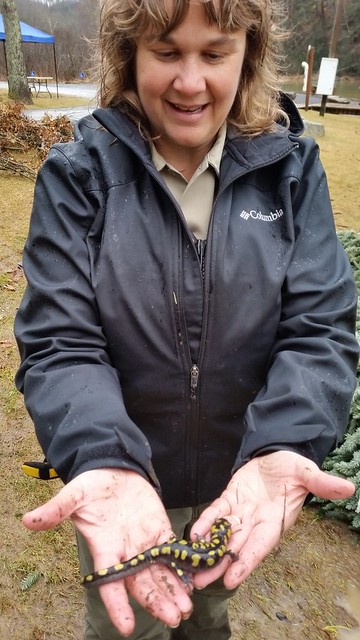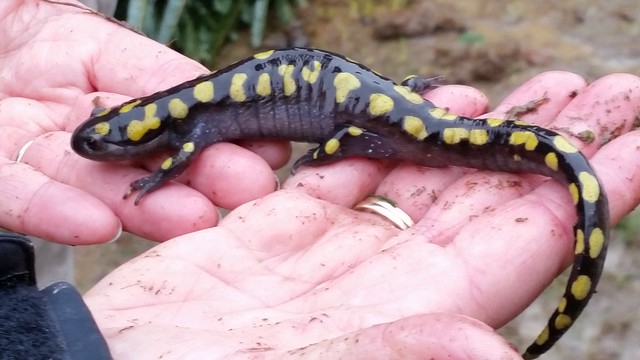Read Our Blogs
Spring Surprise
Darkness had fallen, and hope was fading for a surprise discovery. It was the April 2016 24-hour Bioblitz event at Hungry Mother State Park, and “counters” had been combing the park since sunrise documenting every moth, every fish, every plant, frog, bird, and salamander found within the defined region of the park.
The number of species found had been impressive, but not surprising. And while an updated catalog of natural species is instructive, everyone quietly hoped for something never before noted.

Chief Ranger Visitor Experience Tanya Hall with the exciting discovery at Hungry Mother
Then, as in all good stories, just when hope was gone, the shouting started.
A group of students from Virginia Highlands Community College were investigating ponds near the Mitchell Valley boat dock with their biology professor, Dr. Kevin Hamed, who specializes in herpetology. An egg mass had been found. They confirmed the gelatinous wobbly blob as salamander eggs….and inside the eggs were flecks of green. Eureka! Only the eggs of a Spotted Salamander contain tiny bits of algae: the algae gives oxygen to the developing salamanders, and the carbon dioxide of exhaling baby Spotted Salamanders makes the algae grow: nature’s synchronicity.
This discovery could never have happened without a coordinated, dedicated, educated team of volunteers. “Citizen Scientist” is a term that has gained traction over the past few years, because state agencies are realizing there is much to study in the natural world — but not enough paid staffers to get everything done. State Parks and organizations like Virginia Master Naturalist provide education and volunteer opportunities that expand the world’s understanding of nature’s fascinating intricacies and behaviors.
And the discovery of these Spotted Salamander eggs was exciting because it was an opportunity to dive into more information about one of nature’s more interesting — and, let’s just say it, CUTE species.

Spotted Salamander at Hungry Mother State Park
Scientists had never documented any Spotted Salamanders inside the boundaries of Hungry Mother. And, according to Dr. Hamed, there were other surprises. Dr. Hamed observed that the eggs were late in development and must have been laid later than expected at our latitude.
Worldwide, there are 400 species of salamanders — nearly 150 in North America — and nearly half of those are found in Virginia. Salamanders, by definition, are amphibians, requiring a certain amount of moisture at all times. Spotted Salamanders spend most of their time underground, sometimes using tunnels created by moles or voles. In the spring, when the temperature and moisture conditions are just right, they emerge and head for seasonal (vernal) ponds to reproduce. They often arrive hundreds at a time to find partners, fertilize eggs and deposit as many as 200 eggs on sticks and stems submerged under the water. The eggs will incubate for 4-6 weeks.
Spotted Salamanders begin life in a larval stage, and their larvae are around ½ inch long with external gills and a flat tail that is perfect for moving through water — which is where they will remain for remain for 14-20 weeks. The adult looks very different, with dark gray sides and roundish spots of yellow or orange.
Salamanders are an important part of the food web, providing food for skunks, raccoons, snakes and turtles. When the Spotteds emerge by the hundreds to migrate to mating ponds, imagine what an exciting buffet that must be for their predators! (Thankfully, salamanders make up a large portion of vertebrates in the ecosystem.) By eating insects and worms, they do their part to move nutrients throughout the ecosystem.
Salamanders are also environmental quality indicators: the health of streams can be determined by the number and type of salamanders found there. And recent studies show that they also indicate changes in climate — as some species formerly found on the mid-range of mountains are having to move higher to find cool conditions.
Salamanders are studied for medical purposes because many species can do things that humans would like to know more about — like breathing through their skin and regrowing a tail that has been broken off. What if humans could figure out how to regrow a lost limb?
Citizen Scientists are doing great work all over the Commonwealth of Virginia. And State Parks like Hungry Mother offer year-round education programs that lead to opportunities for observations and counts that aid with the study and preservation of the planet’s most fascinating, and cute, inhabitants.
Learn more about these, and other salamander species from the Virginia Herpetological Society: Salamanders of Virginia.
To see a list of upcoming educational programs and activities at Hungry Mother State Park, click here.
Make your park visit last longer, for overnight accommodations in the cabins and campgrounds click here, or call 800-933-7275.
If you have read the article and have a question, please email nancy.heltman@dcr.virginia.gov.
Search for blogs
By Park
Categories
Cabins
Camping
Fishing
History and Culture
Other
Programs and Events
Trails
Volunteers
Water Fun
Archive
2025
2024
2023
2022
2021
2020
2019
2018
2017
2016
2015
2014
2012













